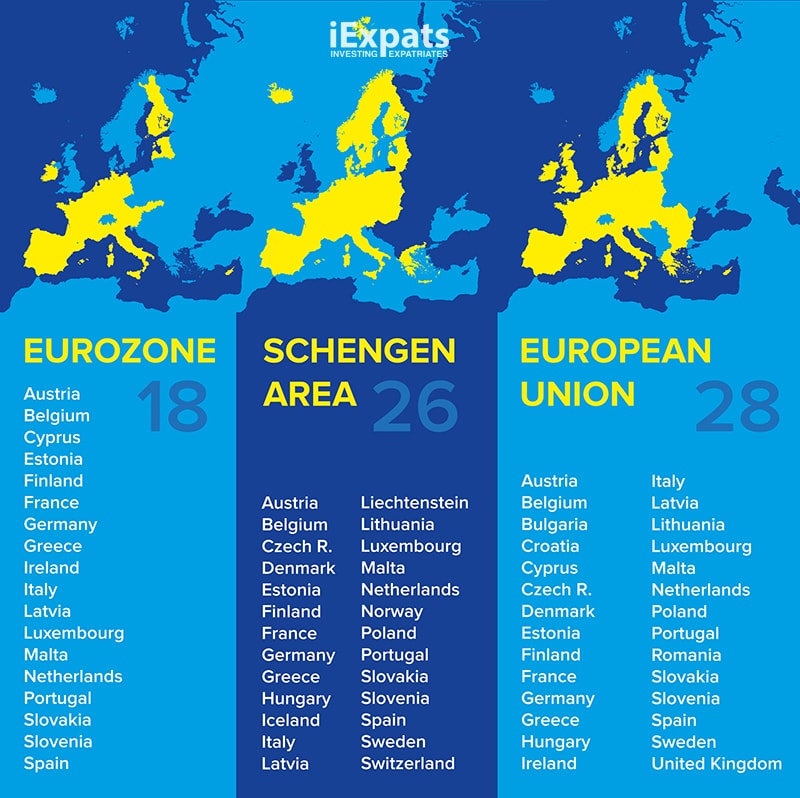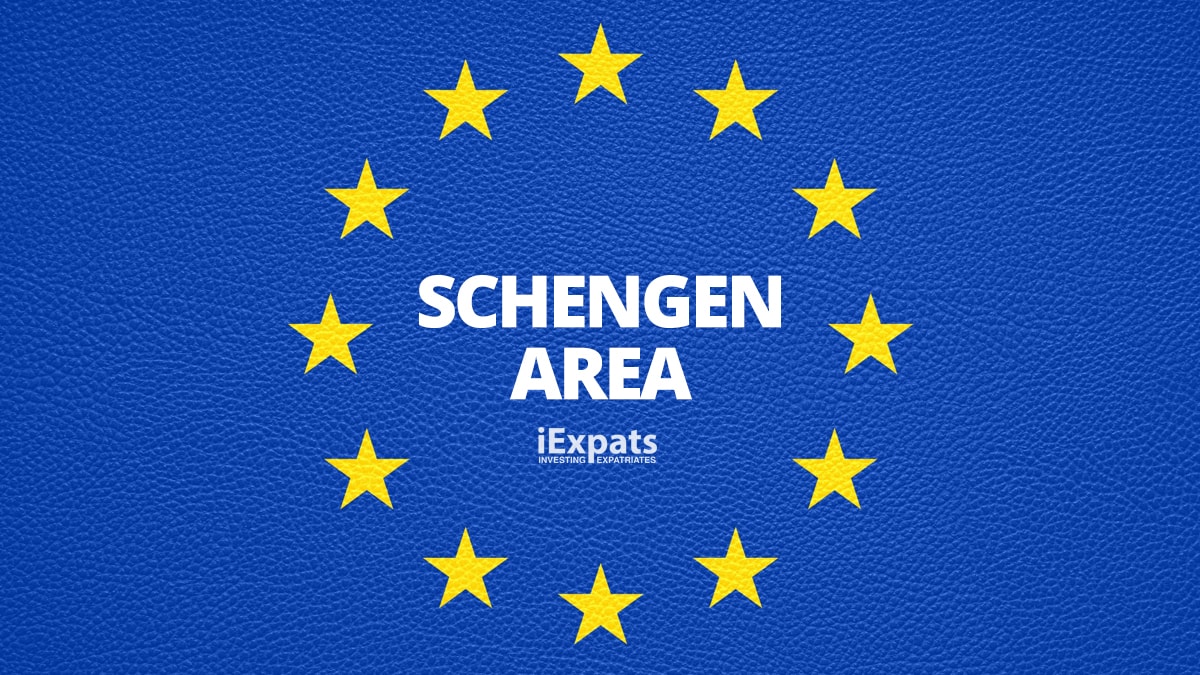Estimated reading time: 7 minutes
A Schengen Visa is a prized travel document that allows non-Europeans free movement across 26 member countries of the European Union.
The visa lets the holder cross the internal borders of the Schengen Area without identity checks.
The EU offers several types of Schengen Visa, offering airport transit and short and long stays. The most popular is a 90-day short-stay visa.
Anyone living in a Schengen Area state enjoys the same privilege as the visa gives, which is one of the reasons golden visas and passports offered to wealthy expats are so popular.
Table of contents
Schengen Area Explained
The Schengen Area is based on the EU concept of freedom of movement that aims to let workers travel across borders to work without restriction.
The name comes from the village of Schengen in Luxembourg where the agreement was signed in 1985. The agreement was enshrined in EU law five years later and border controls started to phase out from 1995.
The Schengen Agreement establishes a common border control policy between member countries that abolishes border posts. However, police can still conduct spot-checks on travellers and deny entry to a country.
The Schengen Area now covers 26 countries, including four non-EU countries – Iceland, Norway, Switzerland and Liechtenstein. The small non-EU states of Andorra, Monaco and The Vatican fall with the Schengen Area as they do not impose border controls.
The EU states of Bulgaria, Romania, and Croatia are in a queue to join the Schengen Area, but are outside the visa-free travel area.
The UK, Ireland and Cyprus remain outside the area. Still, the Atlantic islands of The Azores, Madeira and The Canaries are inside as they are offshore territories of Portugal and Spain.
Schengen Area, Eurozone and EU Maps

Travellers Who Need A Schengen Visa
Travellers from outside the EU fall into two groups – those who must have a Schengen Visa to enter a Schengen Area state and those from a country with an agreement to waive the need for a visa.
Countries with a waiver are travellers who live in the USA, Canada, Mexico, Brazil, Australia and Japan. Britain will join this list when the Brexit transition period ends on December 31, 2020.
The waiver allows a visit of no more than 90 days in a 180 day period.
Travellers to Europe from any other country needs a Schengen Visa, including those living in, but not a citizen, of a country with a waiver agreement who should have a Schengen Visa because they come from a non-waiver country.
The Three Schengen Visas
Travellers can apply for Schengen short-stay and airport transfer visas, while expats and students can qualify for a longer stay.
The three Schengen visas are:
Type A – Airport transit
This visa is for travellers between non-Schengen countries who have connecting flights from a Schengen airport. No entry is allowed to a Schengen Area country.
Type C – Schengen Visa
Travellers can freely travel within the Schengen Area for 90 days in any 180-day period. The visa options include single entry, double entry or multiple entries.
Type D – Long stay
Holders of this visa can stay in the Schengen Area to live, work or study for more than 90 days, but no longer than a year.
Applying For A Schengen Visa
Schengen Visas are issued by the consular service of the Schengen country a traveller intends to visit.
For travellers staying in more than one Schengen Area country, applications should go to the country where the traveller spends the longest time. If the visit is equally split between two or more countries, the application should go to the first country where a traveller lands.
Schengen Visa application paperwork
A Schengen Visa application comes with some strict requirements.
Travellers must provide:
- A completed and signed Schengen Visa application form
- Two passport photographs
- A passport valid for at least three months
- A list of Schengen Area countries planned to visit, including dates, flight information, hotel reservations or other proof of where travellers intend to stay
- An €80 application fee
- Proof of travel and medical insurance cover up to €30,000
- Proof of the place of study or employment for Type D Schengen Visas
- Proof of money covering the stay in the bank – this varies between countries and if accommodation is booked in advance. In France, this is €120 a day without prebooked accommodation or €32.25 a day for budget accommodation.
- Travellers staying with friends or family need a letter from them confirming the arrangements.
To round off the application, travellers will have an interview at the Schengen Area country’s consulate handling the application.
Extra documents are required for students and the self-employed intending to work.
Need Help with your Finances?
Brexit And The Schengen Area
Brexit complicates travel within the EU for British expats.
The UK is no longer an EU state from midnight on December 31, 2020. British expats living in the EU lose the right to freedom of movement with the Schengen Area unless they have become citizens of the EU country where they now live.
But the EU has agreed UK travellers entering the Schengen Area for trips lasting fewer than 90 days should retain visa-free travel. This effectively gives the UK the status of a visa-waiver state.
The UK has granted the same visa-free travel privilege to EU nationals, including British expats.
Schengen Area FAQ
Millions of Schengen Visas are granted yearly as Europe is a popular destination for tourists and expats.
Travellers are subject to rigorous border checks before entering the Schengen Area in a bid to stop criminals and terrorism.
Applying for a Schengen Visa involves some strict checks, and to help, here are some answers to the most asked questions about the Schengen Area.
If you are from a country on the waiver list or have become a citizen of the country where you now live, then Schengen Area travel is allowed.
If not, the rule for non-Schengen foreigners applies.
Yes. Border controls and the police can make stop checks and request to see the documents supporting your application. If you do not have them, your entry can be stopped even though you are already within the Schengen Area.
No. The application should include your itinerary and other supporting documents or will likely be rejected.
Small tweaks to travel arrangements should not pose a problem, but major alterations should be notified to the consulate issuing the visa.
The visa process time depends on which country’s consulate is handling your application. Some can be as quicks as 24 hours, while others can take up to three weeks. Generally, the consulates that process the fewest applications, like Latvia and Estonia, are the quickest.
Your application should include prove of self-employment, any licences you need to work, tax returns and latest bank statements.
EU governments want to see that visitors can support themselves without becoming a financial burden on the state they are visiting, so they need medical cover and money to pay for food and accommodation.
No, the €80 processing fee is non-refundable and must be paid with each application for a Schengen Visa.
A single-entry Schengen Visa allows a traveller to enter the Schengen Area once, but they can travel between the member countries as often as they wish until the visa expires.
However, if the traveller leaves the Schengen Area, they cannot re-enter on a single-entry visa even if it has not expired.
Multiple entry Schengen visas let travellers leave and enter the Schengen Area twice (for a double entry visa) or as many times as they wish (for a multiple entry visa) and allow unlimited crossings of Schengen Area borders.
Related Information
Below is a list of related articles you may find of interest.

Informative Blog. Traveling to any of the countries in the Schengen Area requires a valid visa to enter. If you are planning a visit to the Schengen Zone for business, leisure, or other reasons, it is important to understand the requirements for obtaining a visa.